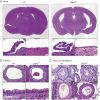Nonsense mutation in CFAP43 causes normal-pressure hydrocephalus with ciliary abnormalities
- PMID: 31004071
- PMCID: PMC6598815
- DOI: 10.1212/WNL.0000000000007505
Nonsense mutation in CFAP43 causes normal-pressure hydrocephalus with ciliary abnormalities
Abstract
Objective: To identify genes related to normal-pressure hydrocephalus (NPH) in one Japanese family with several members with NPH.
Methods: We performed whole-exome sequencing (WES) on a Japanese family with multiple individuals with NPH and identified a candidate gene. Then we generated knockout mouse using CRISPR/Cas9 to confirm the effect of the candidate gene on the pathogenesis of hydrocephalus.
Results: In WES, we identified a loss-of-function variant in CFAP43 that segregated with the disease. CFAP43 encoding cilia- and flagella-associated protein is preferentially expressed in the testis. Recent studies have revealed that mutations in this gene cause male infertility owing to morphologic abnormalities of sperm flagella. We knocked out mouse ortholog Cfap43 using CRISPR/Cas9 technology, resulting in Cfap43-deficient mice that exhibited a hydrocephalus phenotype with morphologic abnormality of motile cilia.
Conclusion: Our results strongly suggest that CFAP43 is responsible for morphologic or movement abnormalities of cilia in the brain that result in NPH.
Copyright © 2019 The Author(s). Published by Wolters Kluwer Health, Inc. on behalf of the American Academy of Neurology.
Figures






Comment in
-
Insights into the pathogenesis of normal-pressure hydrocephalus.Neurology. 2019 May 14;92(20):933-934. doi: 10.1212/WNL.0000000000007495. Epub 2019 Apr 19. Neurology. 2019. PMID: 31004073 No abstract available.
Similar articles
-
Biallelic Mutations in CFAP43 and CFAP44 Cause Male Infertility with Multiple Morphological Abnormalities of the Sperm Flagella.Am J Hum Genet. 2017 Jun 1;100(6):854-864. doi: 10.1016/j.ajhg.2017.04.012. Epub 2017 May 25. Am J Hum Genet. 2017. PMID: 28552195 Free PMC article.
-
NovelCFAP43 andCFAP44 mutations cause male infertility with multiple morphological abnormalities of the sperm flagella (MMAF).Reprod Biomed Online. 2019 May;38(5):769-778. doi: 10.1016/j.rbmo.2018.12.037. Epub 2018 Dec 23. Reprod Biomed Online. 2019. PMID: 30904354
-
Novel biallelic loss-of-function mutations in CFAP43 cause multiple morphological abnormalities of the sperm flagellum in Pakistani families.Asian J Androl. 2021 Nov-Dec;23(6):627-632. doi: 10.4103/aja.aja_26_21. Asian J Androl. 2021. PMID: 34100391 Free PMC article.
-
CFAP43 modulates ciliary beating in mouse and Xenopus.Dev Biol. 2020 Mar 15;459(2):109-125. doi: 10.1016/j.ydbio.2019.12.010. Epub 2019 Dec 27. Dev Biol. 2020. PMID: 31884020
-
Mammalian axoneme central pair complex proteins: Broader roles revealed by gene knockout phenotypes.Cytoskeleton (Hoboken). 2016 Jan;73(1):3-22. doi: 10.1002/cm.21271. Cytoskeleton (Hoboken). 2016. PMID: 26785425 Free PMC article. Review.
Cited by
-
The genetic basis of hydrocephalus: genes, pathways, mechanisms, and global impact.Fluids Barriers CNS. 2024 Mar 4;21(1):24. doi: 10.1186/s12987-024-00513-z. Fluids Barriers CNS. 2024. PMID: 38439105 Free PMC article. Review.
-
Loss of Dnah5 Downregulates Dync1h1 Expression, Causing Cortical Development Disorders and Congenital Hydrocephalus.Cells. 2024 Nov 14;13(22):1882. doi: 10.3390/cells13221882. Cells. 2024. PMID: 39594631 Free PMC article.
-
Central Apparatus, the Molecular Kickstarter of Ciliary and Flagellar Nanomachines.Int J Mol Sci. 2021 Mar 16;22(6):3013. doi: 10.3390/ijms22063013. Int J Mol Sci. 2021. PMID: 33809498 Free PMC article. Review.
-
Risk Variants Associated With Normal Pressure Hydrocephalus: Genome-Wide Association Study in the FinnGen Cohort.Neurology. 2024 Sep 10;103(5):e209694. doi: 10.1212/WNL.0000000000209694. Epub 2024 Aug 14. Neurology. 2024. PMID: 39141892 Free PMC article.
-
The genetic architecture of morphological abnormalities of the sperm tail.Hum Genet. 2021 Jan;140(1):21-42. doi: 10.1007/s00439-020-02113-x. Epub 2020 Jan 16. Hum Genet. 2021. PMID: 31950240 Review.
References
-
- McGirr A, Cusimano MD. Familial aggregation of idiopathic normal pressure hydrocephalus: novel familial case and a family study of the NPH triad in an iNPH patient cohort. J Neurol Sci 2012;321:82–88. - PubMed
-
- Huovinen J, Kastinen S, Komulainen S, et al. . Familial idiopathic normal pressure hydrocephalus. J Neurol Sci 2016;368:11–18. - PubMed
-
- Takahashi Y, Kawanami T, Nagasawa H, Iseki C, Hanyu H, Kato T. Familial normal pressure hydrocephalus (NPH) with an autosomal-dominant inheritance: a novel subgroup of NPH. J Neurol Sci 2011;308:149–151. - PubMed
-
- Funayama M, Ohe K, Amo T, et al. . CHCHD2 mutations in autosomal dominant late-onset Parkinson's disease: a genome-wide linkage and sequencing study. Lancet Neurol 2015;14:274–282. - PubMed
MeSH terms
Substances
LinkOut - more resources
Full Text Sources
Other Literature Sources
Medical
Molecular Biology Databases
